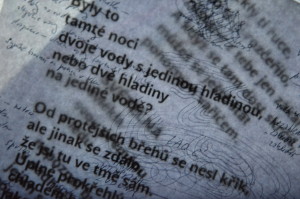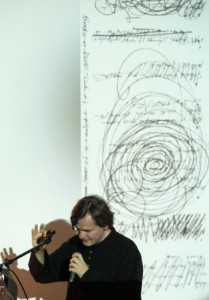 Jaromír Typlt
Jaromír Typlt
Poet, performer, essayist, and art theorist specializing in art brut.
To read:
Critical Reflexions
About visual and sound poetry: Multiplication of the Labyrinth…
About poetry: The Secret of Believability
Jaromír Typlt was born on 25 July 1973 in Nová Paka, a small town in the Czech border region. He studied philosophy and Czech literature at Charles University’s Faculty of Arts, graduating in 1997 with a doctoral thesis on Czech surrealist poetry.
He spent some time working for a therapeutic community for people with mental illness, and in 2000–2010 was the curator of a small gallery of photography and contemporary art.
He currently lives in Prague, where he is active as a performer and is also engaged in the study of art brut.
Typlt first appeared on the Czech literary scene in the 1990s with poetry that was influenced by a surrealist understanding of the imagination (Lost Inferno/Ztracené peklo, 1994), and with short prose works in which he brought to life the unique spiritual atmosphere of his native region (Movable Thresholds of Temples/Pohyblivé prahy chrámů, 1991; Opposite to Overthrow/Opakem o překot, 1996). He received the Jiří Orten Award in 1994.
Since 2000, Typlt has increasingly moved beyond the field of literature towards live performance, music, and the visual arts. Although the written word remains the foundation for all these experiments, the main feature of his work is an exploration of the limits of language (for example, in the books not all that/že ne zas až, 2004, and Pressure/Stisk, 2007). His latest book of poems is called In A While/Za dlouho (2016).
Since 2009, Typlt has regularly collaborated with composer Michal Rataj to create improvised audio-text experiments as part of their joint project entitled Scribbles/Škrábanice (an eponymous CD was released in 2014). In terms of collaboration with visual artists, his work with graphic artist Jan Měřička has been of fundamental importance, resulting in numerous unique artists’ books (e.g., Braincreasers/Hlavolomy, 2000). Working with photographer Viktor Kopasz, he created the bibliophile work Captivity/Zajetí (2001) and a short film in the form of a 3D poem (Vineyard/Vinice, 2012).
Typlt is also the author of audiobooks and short radiophonic compositions (Bark/Kůra, 2006). He likes to work with the voice during live performances and is also engaged in printmaking and photography.
He has applied his long-standing theoretical interest in seemingly marginal areas of literature and art in the discovery of several art brut poets and artists, of whom the “Weather-Maker” Zdeněk Košek has gained significant international renown. In 2013, Typlt published an extensive monograph on the unjustly overlooked Czech avant-garde sculptor Ladislav Zívr.
Translations of Jaromír Typlt’s poetry have been published in various magazines and collections, including Hebenon (Italy, 2011), Die Horen (Germany, 2012), Wyspa (Poland, 2016), Nunc (France, 2016), and Akhali saunje (Georgia, 2017).
In October of 2010, he attended an artists’ residence at the Hesse Literary Forum in Wiesbaden, Germany, and in September 2016, an artists’ residence in Tianjin, China.
He has presented his experimental literary performances at international festivals in Vilenica, Krakow, Berlin, Frankfurt-am-Main, Vilnius, Tbilisi, Xichang and many other places.
Since 2006, Typlt has operated his own website, www.typlt.cz.
(Translated by Stephan von Pohl.)
(See only with 3D glasses, or find here 2D version.)
Reading the image and viewing the words…
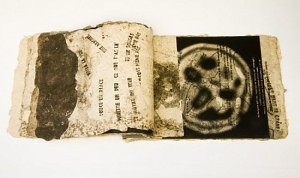 The text offers the author’s personal observations from his close collaboration with graphic artist Jan Měřička in creating several artist’s books in Liberec from 1999 to 2003. On the books’ pages, printed on original handmade paper using etched copper plates, the nature of the poetic word underwent a tangible transformation. Both authors’ aim was to abandon established ways of accompanying text with illustrations and even to erase the boundary between reading and viewing altogether.
The text offers the author’s personal observations from his close collaboration with graphic artist Jan Měřička in creating several artist’s books in Liberec from 1999 to 2003. On the books’ pages, printed on original handmade paper using etched copper plates, the nature of the poetic word underwent a tangible transformation. Both authors’ aim was to abandon established ways of accompanying text with illustrations and even to erase the boundary between reading and viewing altogether.
read more
Scribbles – Rataj/Typlt
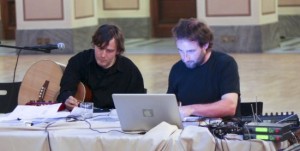 Jan Faix: For quite some time now, the work of Jaromír Typlt has been shifting from “traditional” forms of written poetry towards more abstract forms such as performance art or other multidisciplinary projects. For “Scribbles”, he has teamed up with leading Czech composer and multifaceted electronic experimenter Michal Rataj. Rather than setting poetry to music – which has a long tradition in Czech classical and popular music – their joint project represents an original contribution to the experimental search for new forms of art outside of classical branches or genres, and unbound by the principles of the self-contained work of art.
Jan Faix: For quite some time now, the work of Jaromír Typlt has been shifting from “traditional” forms of written poetry towards more abstract forms such as performance art or other multidisciplinary projects. For “Scribbles”, he has teamed up with leading Czech composer and multifaceted electronic experimenter Michal Rataj. Rather than setting poetry to music – which has a long tradition in Czech classical and popular music – their joint project represents an original contribution to the experimental search for new forms of art outside of classical branches or genres, and unbound by the principles of the self-contained work of art.
read more
About the poetry of Jaromír Typlt
(Visual and Sound Poetry: Multiplication of the Labyrinth…)
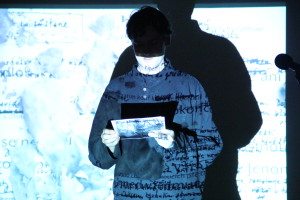 In the early nineties, Jaromír Typlt presented himself in the context of Czech literature as one of the most distinctive authors of the young generation particularly through his poetic works and numerous essays and literary-critical writings. In his beginnings, he was influenced by the self-destructive poetics of rock music as well as by the growing inspiration by surrealism (cf. Typlt’s first work, “heavy-metal mass composition in F minor” Koncerto grosso / Concerto Grosso, 1990).
In the early nineties, Jaromír Typlt presented himself in the context of Czech literature as one of the most distinctive authors of the young generation particularly through his poetic works and numerous essays and literary-critical writings. In his beginnings, he was influenced by the self-destructive poetics of rock music as well as by the growing inspiration by surrealism (cf. Typlt’s first work, “heavy-metal mass composition in F minor” Koncerto grosso / Concerto Grosso, 1990).
Typlt perceived poetry namely as a counterpoint to dull routine and utilitarianism. His creative self-consciousness was pervaded with his desire for constant verbal and sensational initiation and for emotional suggestion, which, nevertheless, time to time materialized in the shape of mannerist gestures. Also Typlt’s prosaic (Pohyblivé prahy chrámů / Movable Thresholds of Temples, 1991, Zápas s rodokmenem / Fighting the Family Tree, 1993) and dramatic (Dříve než vzápětí / Earlier than Afterwards, 1994) works were of similar character. With their emphasis put on all-embracing imagination and the play with absurd dimensions of language, Typlt’s writings more and more adopted the shape of a provocative proclamation “à la Dalí”, which is dominated by structure and form.
The selection of works titled Ztracené peklo / Lost Inferno (1994) represents a sort of programme review of Typlt’s early writings, consisting, among others, of the collections Procitající teurgos / Teurgos Awakening and Epocha Setmění / The Epoch of Nightfall (subtitled Kytaromachie / Guitarmachy). Here, Typlt tried to sketch, through cascades of metaphors, neologisms, and archetypal images, the “new cosmogony”, a sort of poetic universe construed out of defiance, streaming out of the subject himself.
The postulate of a forced breakthrough into the absolute equilibrium of the creative truth is conveyed by the essayistic manifest titled Rozžhavená kra / Red-Hot Ice Floe (1993/1996), in which Typlt categorically rejects all modern conventions of contemporary art and literature.
After 2000, Typlt has been publishing his own texts only sporadically, mostly in form of bibliophilic prints. In these, the author’s literary expression is closely intertwined with the visual art; the graphic element and the word complement and inspire one another: it is only the moment of their mutual interaction that yields the unity of meaning. Such are the so-called “authorial books”, which Typlt has been creating together with the artist Jan Měřička since 1999. Some of these texts have been collected in the book titled že ne zas až / that-the-un-struck (2003).
It was as late as in 2007 with the publication of the book Stisk / Squeeze (2007) that Typlt re-entered the wider literary communication; with the book representing a varied composition of his poetic, prosaic, and essayist work from the period 1993 – 2007. In these texts, Typlt did manage to manage do without programme accentuations and proclamations of linkage with surrealism. Nevertheless, Typlt has continued to build his style upon expressive creative gesture, experiment, and play. The prosaic texts are governed by strong lyrical elements and experiments with structure and composition. Their thematic level is enfolded in dreamlike indeterminateness, and the logic of narration is penetrated by deliberate absurdity. Also the poetic texts of the collection are playful and experimental; to a large extent building up on the graphic elements of expression; with irrational imagination clashing with constituents of the language of discourse.
Adopted from Slovník českých spisovatelů po roce 1945 / Encyclopaedia of Czech Writers after 1945
Entry authors: Vladimír Novotný and Karel Piorecký
Some poems
That is talk hitting
I lie
at the bottom
of hardly hearable
rattles and thrums.
Hardly hearable,
yet persistent. They push through,
intruding upon me from below,
rubbing off on me, lightly
yet very, very lightly
they
keep hurting.
As if something frayed
between the floor and the ceiling,
somewhere in places where they cannot yet be told apart.
Particularly that high-pitched,
almost clear,
at times intermittent
quiver.
That is talk hitting.
It might be women chatting downstairs.
Translated by Veronika Revická
More poems
Fragment B101 (2011, translated by David Vichnar)
When You (2003, translated by David Vichnar)
More poems – (1990–2007, translated by Veronika Revická) Instinctea, Alive, Lids
More poems 2 (1990–2010, tranlated by David Vichnar) – Defloration, Anxietea, Concertea, In the Sign
A mutated radiophonic reading
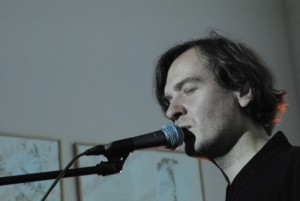 I have been trying in various ways since roughly 1999 to find new approaches to the tried-and true – but in my opinion not very interesting – approach to author readings. I started to call my approach “mutated author readings”, perhaps in part because it is constantly growing and taking on new, unforeseen forms.
I have been trying in various ways since roughly 1999 to find new approaches to the tried-and true – but in my opinion not very interesting – approach to author readings. I started to call my approach “mutated author readings”, perhaps in part because it is constantly growing and taking on new, unforeseen forms.
Since the very beginning, I have used computer-altered recordings of myself which have allowed me to agree as well as to disagree with myself, to interrupt myself, to cut myself off, to chime in… Over time, I naturally tried to use this approach to create a final recording. These recordings later formed the basis for creating this mutated radiophonic reading.
More informations – Radiocustica
Photo by Stanislav Chlup, Renata Štěpařová (portraits) and Jaromír Typlt.
